What is Software as a Service (SaaS)? SaaS is a self-service software that can be accessed through the web and is managed by a third-party vendor. This cloud-based model is the most successful software delivery model today. Before diving into the SaaS concept, it is useful to take a time capsule to the 60s and gain an understanding of how it all started.
The early time-sharing SaaS model was the IBM 360 Model 67. This was the IBM mainframe that provided processing power to banks and government agencies. These organizations relied on IBM to rent virtual power and space. This service came to be known as time-sharing.
In the 1970s and 1980s, personal computers gained popularity and organizations decided to invest in on-premise applications that came in the form of CD-ROMs and floppy disks. The problems that persisted with this model were the high licensing fees, limited to no updates, and minimal tech support.
The next evolution was the SaaS’s forerunner, application service provider or ASP, that gained attention around 1996. The ASP model provided access to a software application over a network (through HTTP). Looks similar to SaaS, right?
However, ASP is based on the single-tenant architecture (i.e., a single instance of a software application serves only one customer). Moreover, the vendor needs to manually set up the login and environment, which eventually led to its adoption failure.
Finally, 1999 marked the entry of the first pure customer relationship management (CRM) SaaS product — Salesforce. The company built its SaaS product from scratch and popularized it with the marketing statement, “The End of Software.”
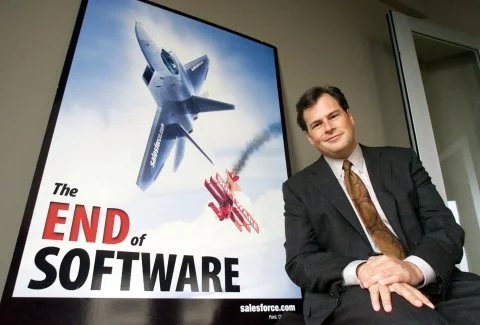
Image credits: The Software Report
Leading the way, Salesforce became a top American cloud-based company and recorded a revenue of $6.86 billion in the third quarter of 2021 alone.
In chronological order here is what the evolution of SaaS looks like:
IBM 360 Model 67 > Floppy disks and CD-ROMs > ASP > SaaS
That sets the stage for SaaS! Now it is time to explore SaaS in detail.
What is SaaS in Cloud Computing?
SaaS stands for software-as-a-service, a cloud computing model for the delivery of software on an on-demand basis. The end-user does not need to install the software application on their computer system. Instead, they can access the software through the internet at any time, from anywhere.
But, what is the cloud computing model?
The word cloud is a metaphor for the internet, and the cloud-like shape symbolizes a distributed virtual network. Cloud computing helps avail computing resources on-demand (such as computing power and storage space).
In the case of a SaaS application, the cloud acts as a central point from where software can travel to many locations at the same time to offer a virtual service.
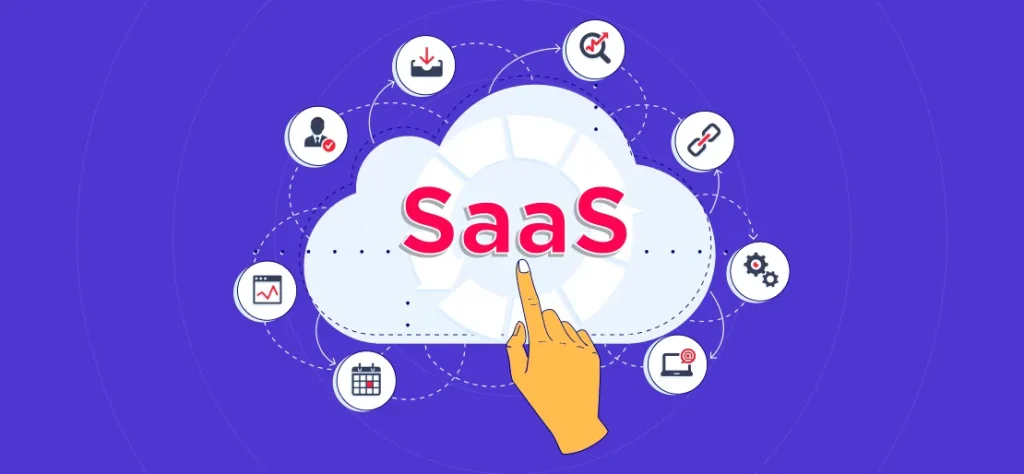
The widely known, modern SaaS companies include Dropbox, Canva, Mailchimp, Shopify, Magento, Slack, and even Salesforce.
SaaS vs On-Premise Applications
Before moving on to develop a SaaS application, let us understand the difference between SaaS and on-premise.
SaaS Application: This is a cloud-based software that is developed and maintained by a third-party vendor. SaaS applications support a multi-tenant architecture (i.e., a single instance of the software is shared across the server and serves multiple users).
On-Premise Application: This is a bespoke software customized according to the organization’s needs and is private to them (i.e., it is not shared). On-premise applications can be built by the in-house team or an outsourcing partner can help in the development process.
Refer to the table below for a parameter-wise comparison between SaaS and on-premise:
| Parameter | On-Premise | SaaS |
|---|---|---|
| Definition | Customized software that is private to an organization. On-premise is also known as enterprise software. | A common software solution that is deployed on the server by the vendor and available to many. |
| Hosting | On-premise servers or third-party hosting providers such as AWS, Azure, and GCP | Managed by the software vendor |
| TOC (Total Cost of Acquisition) | One-time development fees, ongoing maintenance fee | Monthly, bi-annual, or annual fee based on SaaS solution’s pricing model |
| Control | Full control over the software | Less control as everything is managed by a third-party provider |
It can be taxing to decide between building an in-house application or buying enterprise software. Visit our build vs buy blog for help with making an informed decision.
What is the Difference Between SaaS, PaaS, and IaaS
SaaS, IaaS, and PaaS are the three models of cloud computing. Here is how they are different from each other:
- IaaS (Infrastructure as a service): IaaS is a cloud-based model where the vendor manages the operating system needs such as virtualization, storage, networking, and server space.
- PaaS (Platform as a Service): PaaS is a cloud-based model where the vendor manages the hardware and software resources on its own infrastructure. Used mainly by developers, a PaaS solution allows them to develop, run, and manage the applications easily.
- SaaS (Software as a Service): SaaS is a cloud-based model where the vendor manages the entire application. The users can directly gain access to the software and enjoy its benefits from their web browsers.
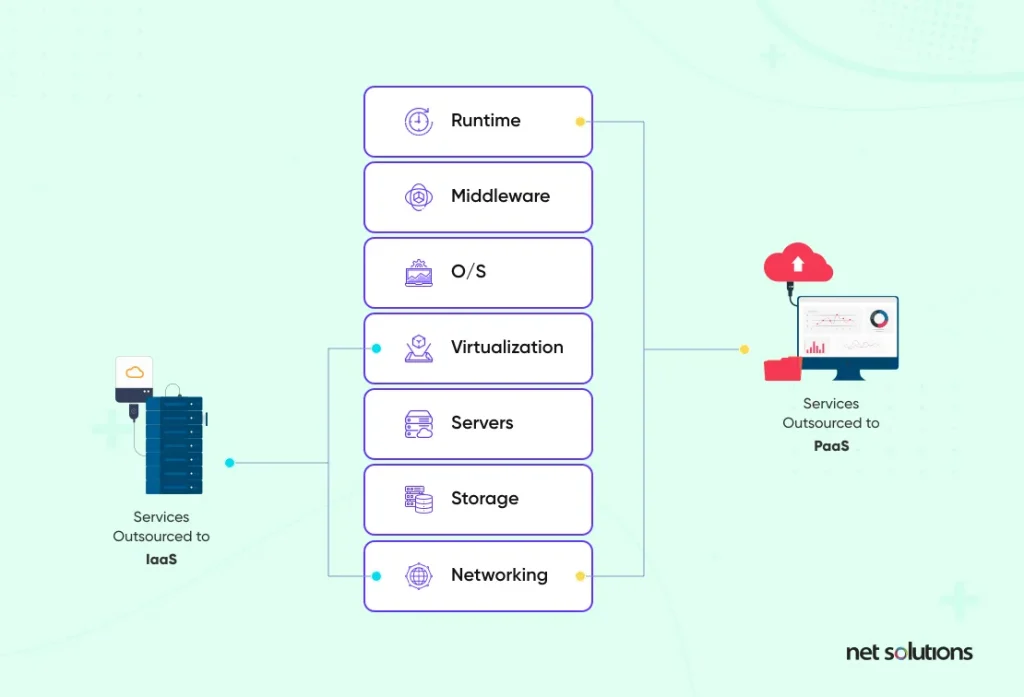
For a comprehensive comparison, visit this blog that discusses IaaS vs PaaS vs SaaS in detail.
Vertical SaaS vs Horizontal SaaS
The target audience helps define the type of SaaS product a business should build. That is, will it be a vertical SaaS or a horizontal SaaS product.
For a better understanding, here’s a difference between the two:
Vertical SaaS: If the target audience belongs to a specific industry, such as healthcare, banking, or retail, the business will have a vertical SaaS model. This software solution has a narrower market and only solves problems for that particular industry.
Vertical SaaS is often the only option for organizations dealing with critical data. For instance, banks rely on vertical SaaS due to compliance and regulation constraints.
Example: Clio, a vertical SaaS solution for legal practice management, or Textura for construction management business
Horizontal SaaS: A common SaaS solution that solves problems of various industries is called a horizontal SaaS model. This software solution has a broader market and offers a common solution for all (irrespective of the industry type).
Example: Slack, a communication-based application, can be used by people in healthcare, banks, IT, or any other industry.
The SaaS Architecture
Software as a service is based on a multi-tenant architecture. In this architecture, a single instance of software is shared across the server, and several tenants (users) can access it from anywhere and at any time.
Multi-tenancy is a requirement for a SaaS vendor to be successful.
— Marc Benioff, CEO, Salesforce
In a multi-tenant setup, the different customers are unaware of each other’s data as it is stored exclusively across dedicated databases. Moreover, the customers can customize the SaaS solution at their end without affecting others’ views and settings.
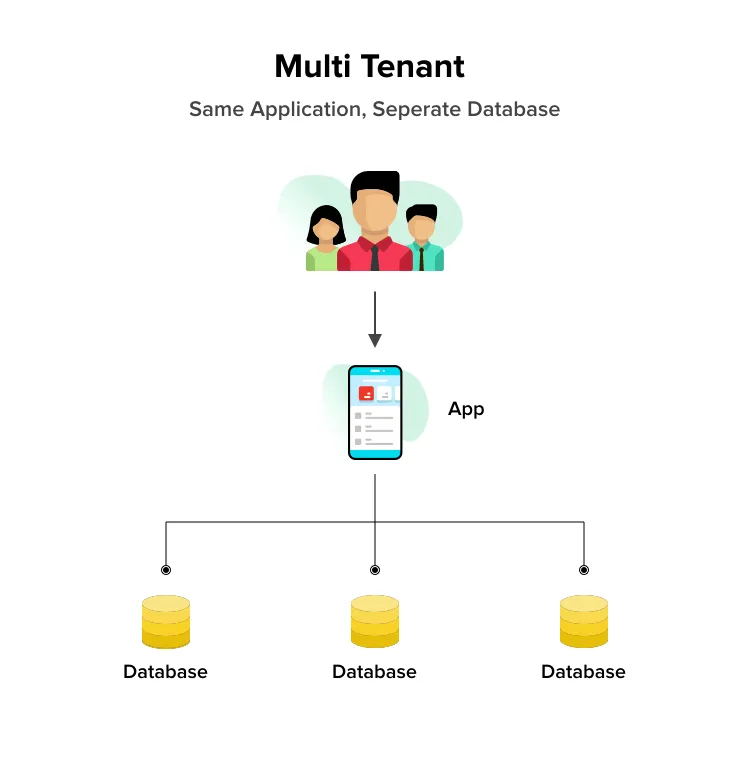
Advantages of SaaS
The benefits of SaaS are different for vendors and customers. The SaaS benefits from both perspectives are discussed below:
For a business investing in SaaS:
- Gartner estimates that worldwide end-user spending for SaaS would be around $171,915 million in 2022.
- According to a recent Statista survey, 38% of respondents believe that SaaS plays a significant role in achieving their business goals. This means SaaS is going to play a significant role in the way forward.
- Offers higher revenue over time (if there is product-market fit)
- Offers competitive edge (if there is disruption to the market or a better value proposition is offered compared to competitors)
For the end-user:
- Anywhere, anytime access
- Flexible pricing (pay-as-you-go-basis)
- Ability to solve the core problems
- Regular updates
- No maintenance burden
- Easy scalability
How to Start a SaaS Business: Step-by-Step Process
This part covers the 12-step process to start a SaaS business (from the Agile development perspective). The steps include:
- Come up with a SaaS Idea Coming up with an idea for a SaaS model is the most crucial step that will define the success of the business. The idea should be unique, solve a real problem that is experienced by the target audience, and have a validated proof of concept (PoC).
Some of the helpful tactics to come up with a SaaS idea:
- Upwork Research Run a search across Upwork for developer job postings. What are the people hiring developers for? If that seems like a recurrent problem, a business could create a SaaS product for it. This is a great starting research method when creating an enterprise SaaS solution.
- Twitter Research Conduct Twitter Research to gain a sense of what is trending. Look out for popular threads about SaaS ideas. Read through the comments and make it a practice to follow popular SaaS-related accounts that receive a good amount of traction.
- App Store Method When the industry that will benefit from the SaaS product idea has been identified, the business can search popular apps using industry-relevant keywords or for apps that will be direct competitors on the Play Store and Apple store. For example, if the plan is to build an eCommerce app, running searches for Magento or Shopify apps can be helpful.
Look for 1-star reviews on the apps to understand what people are complaining about. Right there, the business will get ideas about what SaaS product they need to build and what problems they need to solve for their target audience.
- Interview the Target Audience Conduct interviews with the target audience. The focus should be on understanding what these people are using spreadsheets for. This is because that will be the work that they are doing manually on their end. Automating manual work is a great way to gain early adopters and drive SaaS growth.
- Create a Proof of Concept (PoC) Developing a proof of concept (PoC) helps validate the technical feasibility of a new and untried idea. Creating a PoC helps assure that the idea can be converted into a functional SaaS product.
Here is a flowchart that needs to be followed when creating a PoC:
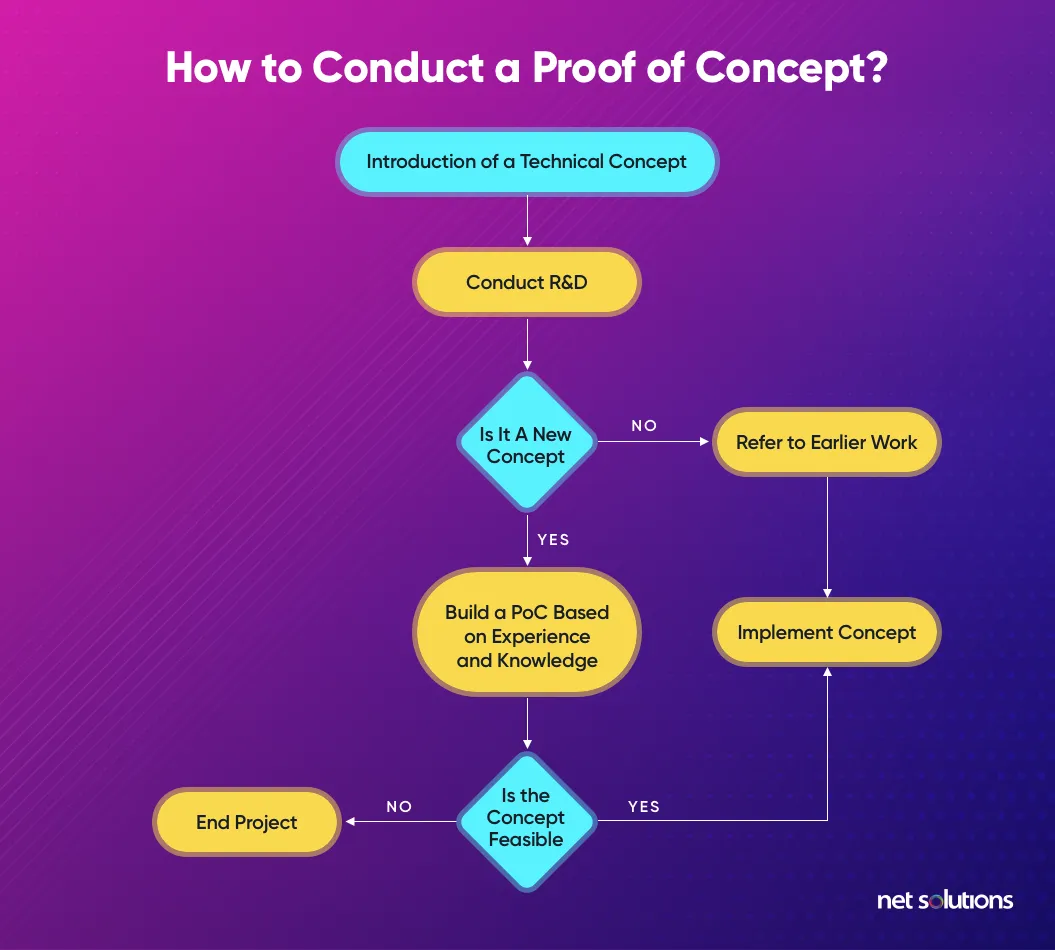
- Do Market and Competitor Research Once a business has “The Idea,” the next step is to conduct market research and define the competitors in that space. This will help to understand:
- Who are the competitors?
- What are their strengths and weaknesses?
- What weakness can be improved upon?
- What is the market value of their products?
The answers to these questions will help with the next step of defining the requirements. In the case that the prevalent competitors are already serving the target audience in the best way possible, iterate back to the first step and rethink the idea.
- Choose Between In-House and Outsourcing Choosing between in-house development and outsourcing is an important milestone for any SaaS product. The in-house development option is viable if the business has a fully functional in-house development team and resources for the job.
However, for a startup, outsourcing is the recommended option. Hiring an outsourcing team should be the go-to option for a business that operates under a bootstrapped setup and wants to speed up the development time.
According to a Deloitte report, some of the most prominent benefits of outsourcing include:- Cost reduction
- Flexibility
- Speed to market
- Access to tools and processes
- Agility
- Choose the Right Technology Stack Choosing a technology stack means selecting the SaaS architecture, frameworks, database, backend and frontend technologies, and other supporting tools.
Here is a table that summarizes the best technology stack for SaaS applications:
Aspect Meaning Technology Recommendations Frontend Development An interface that the users can see on their screens. - React
- Angular
- Vue.js
Backend Development Invisible to the users and helps build the core functionality of the SaaS app - Ruby on Rails
- Node.js
- Django
Database Maintains all the essential data related to the application at a centralized location - PostgreSQL
- MySQL
- NoSQL
- Choose a Cloud Vendor — AWS, Azure, GCP Choosing the right cloud vendor is extremely important for a SaaS product. The most popular ones include — Amazon AWS, Microsoft Azure, and Google Cloud Platform.
According to Gartner’s Magic Quadrant for Cloud Infrastructure and Platform Services, all three cloud service providers have been pronounced leaders as of July 2021.
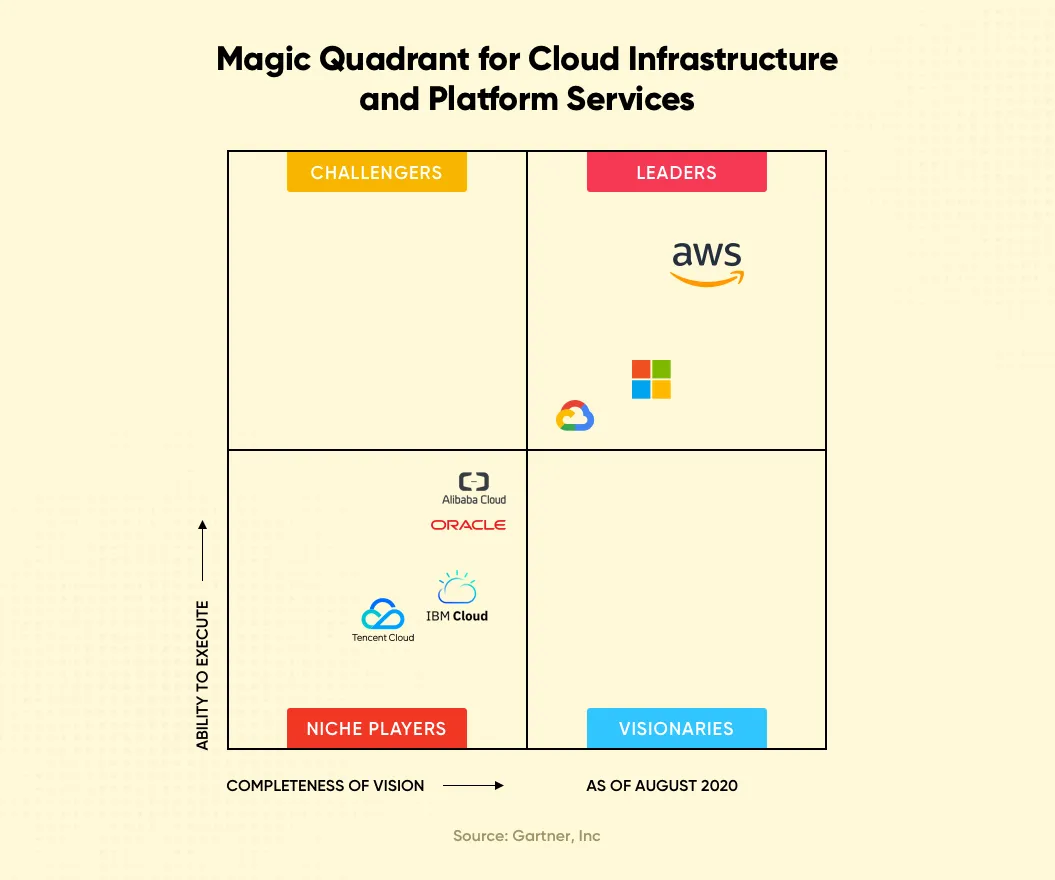
To make the best pick, a business needs to analyze their requirements upfront and evaluate the options with those requirements in mind.
Some of the parameters that they need to consider include:
- Pricing
- Compute Power
- Storage
- Technology Abilities
- Minimum Viable Product Development A minimum viable product (MVP) is a basic, launchable version of the SaaS product that supports the most critical features, or the features that define the product’s value proposition. Once the MVP is launched in the market, initial review and feedback are collected, forming the basis for further development efforts.
The MVP development part is a combination of different micro-phase milestones that the business needs to take care of. Starting with:
- Requirements Analysis This step is another crucial step where the SaaS product development process begins for real. The business needs to define the requirements for their SaaS product.
The requirements are best defined with the help of the MoSCoW rule of prioritization( i.e., must-have, should-have, could-have, and won’t have features), where:
- Must-Haves — cover the essential features that will go into MVP development. An example could be a login and authentication system for users. In Agile development, these features are placed at the top of the product backlog.
- Should-haves — cover the important features that can go into further development cycles and can be prioritized post-MVP development. These are placed somewhere in the middle of the product backlog.
- Could-Haves — cover the good-to-have features, but it won’t be painful to leave them out if necessary. These are placed somewhere at the bottom of the product backlog.
- Won’t-haves — are non-important features that can be left out and can be left for further discussions (across the product’s lifetime).
- Design Start with creating a prototype for the SaaS product. A prototype will help in validating the UI/UX flow of the product. This stephelps answer what the product will look and feel like.
The business can present the prototype to the development team and the stakeholders and gain feedback. Also, this helps attract seed funding for the SaaS product.
- Code The developers work on the coding part in time-boxed sprints as a part of the Agile development process. The developers pick the tasks from the prioritized product backlog and conduct sprint planning before starting the development process.
In each sprint, the developers work on every user story (a feature that adds value to the user’s journey) and submit it to the testing team for review.
- Test The testing team conducts various manual and automated tests for the completed tasks to identify bugs. The Agile testing team also works in time-boxed sprints to complete the tasks at hand.
The testing report is then sent back to the developers for fixing errors and bugs. The process continues until all the user stories are properly functional and meet the customer’s needs.
- Requirements Analysis This step is another crucial step where the SaaS product development process begins for real. The business needs to define the requirements for their SaaS product.
- Choose the SaaS Pricing Model Planning the pricing for a SaaS product is another essential part of setting up a SaaS business. The various pricing models that are relevant to the SaaS industry include:
- Free-Trial: Offer the product for free for a week or 14 days with limited accessibility
- Freemium: The subscription is free, but the functionality access is restricted
- Flat Rate: There is universal pricing for everyone irrespective of users and business size
- Pay-as-you-go Basis: The price depends on business scalability (i.e., the customer pays for only what they use and can change their plan as and when they need to add/remove features)
- Per User: The price depends on the number of users of the SaaS product. More users means higher pricing, and vice-versa
- Feature-based: Pricing depends on the features that the customer opts for. The more features the customer gains access to, the higher the pricing
- Business Size: Pricing differs based on business size. For instance, the plan for a startup, a mid-sized company, and an enterprise will be segmented into different groups
- Plan SLA (Service Level Agreement) A service level agreement (SLA) is a formal document that highlights the software vendor’s offerings and the level of service that a customer should expect.
An SLA primarily covers:
- Service description — what the product does and how it will benefit the customers
- Service reliability — the uptime guarantees and handling in case of downtime
- Reporting — how can the customers reach out to report any issue related to the product
- Updates’ Information — how often the SaaS product will be updated, and through what medium will the changes be conveyed
- Penalties — what will happen if the SLA conditions aren’t met
- Response Time — how much time will it usually take to respond to the raised ticket
- Launch Once everything is in place, the business can plan for “The Launch” and they will need to create a launch strategy for their SaaS product. They need to follow the “ship it fast” approach to make sure that they can enjoy the early win.
Ensure that the following steps are in place:
- Plan a launch date
- Develop a website and a mobile app for both Android and Apple store
- Create an introductory blog and email
- Reach out to the influencers who can talk about the product
- Plan a webinar/podcast for product introduction
- Market Creating a product is not enough — the business needs to build awareness around it too. Invest in marketing campaigns to create hype around the product. Twitter, Instagram, Facebook, and LinkedIn are good platforms to start with.
The following digital marketing tactics can be leveraged to gain early adopters:
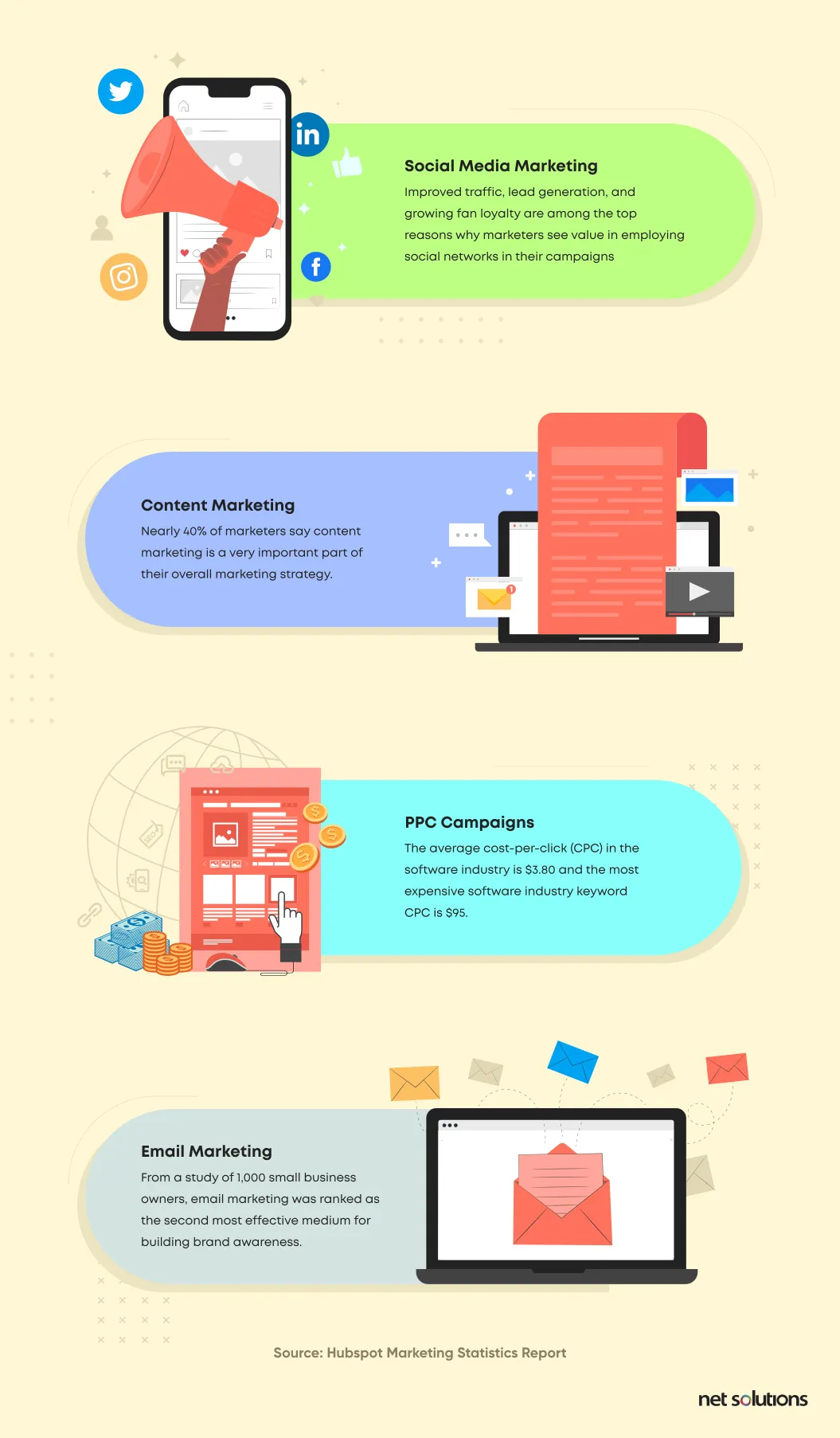
- Continuous Improvement Continuous improvement implies that a business needs to offer regular updates and upgrades to their SaaS product. Maintain a shipping cadence for the product (i.e., do not let the customers wait). Fix errors and introduce new features and functionalities throughout the product’s lifetime.
Here are some strategies to follow:
- Keep digital channels open for feedback. Listen to what customers are saying about the product and tend to their needs.
- Offer small and quick updates over large and slow ones
- Maintain minimum technical debt. This will help to maintain minimum cruft and iterate through the product in a fast and easy way
- Consider code refactoring seriously. This will help in eliminating the poor design choices in the code. Thus, it will lead to better continuous improvement cycles.
SaaS Challenges + Solutions
The demand for SaaS is high, which means that many small-scale and large-scale businesses are investing in building SaaS applications. However, most of them are failing to create a lasting impression.
An estimated 92% of SaaS companies fail within 3 years despite growth and funding.
— Lighter Capital
Several bricks go into building a robust wall. The same is the case with a SaaS product. If a business does not work cautiously on building the foundation, the wall is likely to fall.
Here are some reasons why SaaS products fail and the corresponding solutions to overcome the challenges at hand.
- Missing Product-Market Fit A product-market fit is achieved when a business creates a product that solves the problems of their target audience. If there is a need and the product manages to address it, the business has achieved a product-market fit. In such a case, their customers become their marketers, who endorse the product through word of mouth.
Failure is evident if the business fails to address the problems and develop a SaaS solution that is not pragmatic.
Solutions:
- Research the market. Before coming up with a SaaS idea, understand the needs and problems of the target audience. Brainstorm around ideas and create a list that seems promising.
- Analyze existing SaaS businesses in the market to see if they already have a product based on a short list of ideas. Also, analyze where the existing solutions lack so that the new product can offer a better experience.
- For new ideas, create a proof of concept to check the technical feasibility of the idea.
- Create discussion groups, a combination of development teams, stakeholders, and limited test users to validate the need for a specific SaaS product in the market.
Finalize the idea that would make a difference after running a vote across the discussion groups.
- Great Product, No Marketing Most SaaS businesses follow an approach — (1) Develop a product, (2) agile test that product, (3) launch the product into the market with a launch plan that includes announcing it on Twitter or other social media channels and waiting for it to be the next big thing in the market.
Unfortunately, it does not work that way. Instead, the ideal approach is to adopt the product mindset over a project mindset. Marketing is equally important because, without effective marketing initiatives, even a great product is likely to go unnoticed.
Solutions:
- Create a SaaS marketing plan by looping in marketing, sales, customer service reps.
- Focus on SEO wherever there is content. The better the Google rank, the better the chances of conversions. A business can also spend on Google AdWords for better reach.
- Publicize SaaS offering through social media posts, email campaigns, blog posts, guest posts, etc. Businesses can also try influencer marketing, which works wonders nowadays.
- To gather eyeballs on the product, offer free trials to the customers. Urge them to try the product and receive valuable results. The pitch should be talking about how the new product will make a difference in the user’s life.
- Stick to the low-price, low-complexity rule. These are the two parameters that customers will judge a product for.
- Maintain a healthy relationship with the early adopters. If they stick to the product initially, send them a gift. This is something that Freshbooks does. This SaaS company sends a cake to its loyal customers to maintain an ongoing relationship.
- Inability to Respond to Change The inability to showcase agility skills when responding to change leads to product failures. For instance, a business launched a SaaS product a month ago, and they receive feedback that they fail to respond and iterate through — failure will be the result.
If the business responds to feedback but spends a lot of time iterating through the changes, failure is yet again evident. In short, they need to showcase agility skills to stay relevant and valuable.
Solutions:
- Build an MVP before moving to the full-scale product. An MVP that presents its core functionalities should be the goal. This can be a good starting point for gathering loyal customers and honest feedback to start revisions.
- Emphasize SaaS application development by following the microservices architecture (i.e., smaller modules of the bigger application that are loosely coupled). This makes it easier to iterate through the suggested changes as the change to a particular module does not affect the other modules’ functionality. Thus, less downtime.
- Maintain a lower amount of cruft in the code (i.e., the unwanted parts of the code). The lower the cruft, the lower the technical debt.
Most importantly, give it time. Overnight success is a myth; do not fall for it. Instead, drive constant efforts towards: Launch. Market. Gather Feedback. Iterate.
Key SaaS Metrics
How should a business measure the success of their SaaS business? Here are some key performance indicators (KPI)s to consider:
- Users over a period of time — is the number of users gradually increasing (even if it is a small percentage)
- Annual Recurring Rate — is the annual recurring revenue (ARR) based on monthly recurring revenue (MRR). For instance, the MRR IS $1000, the ARR will be equal to $1000 multiplied by 12 (i.e., $12000)
- Customer Churn — measure business lost over a time period
- Customer Lifetime Value (CLV) — is the average amount of money paid by the customers over the course of the business relationship. CLV calculators can easily be found online for fast and accurate evaluation.
- Net Promoter Score (NPS) — measures customer’s satisfaction with the SaaS product. Surveys (numerical scale basis) can be conducted to evaluate a customer’s experience with the product to evaluate the NPS score.
11 Point Checklist to Ensure SaaS Success
To succeed in a SaaS-triggered digital transformation initiative, there are a few best practices that align well with the changing times and needs.
Here is a glimpse into some of them:
- The focus should be to create a PoC followed by a prototype and then an MVP. Learn about PoC vs Prototype vs MVP
- Create interactive advisory videos for the customers to help them understand the working of the UI and other noteworthy benefits.
- Offer distinct and affordable pricing models that are better than the competitors. These offerings should be easy to understand, as complex pricing models can put off potential customers.
- Work on enhancing the experience design across touchpoints to eliminate churn rate. These days the end-to-end customer experience of most of the SaaS products seems disconnected. A business can make a difference here by offering seamless sign-ups and intuitive and responsive UX.
- Deploy data analytics to analyze the reasons behind churn rates. These results can also help to identify SaaS product shortcomings so that they can be improved.
- Offer valuable and on-time customer support as it acts as a key ingredient to SaaS vendor success.
- Offer regular and timely updates and bug fixtures to stay one step ahead of the competition.
- Ensure that the SaaS product can operate efficiently with lower bandwidths to run uninterrupted with low-speed internet connectivity.
- Look for strategic partnerships to expand the user base and reach across the globe. This can help gain scaling advantages for the SaaS product, which can act as a cash cow.
- Analyze the business’ product portfolio from time to time. Make informed decisions by filtering out product offerings and services that offer little to no value and show no signs of growth. According to McKinsey, SaaS vendors that manage their portfolios achieve enterprise-value-to-revenue multiples twice those of passive portfolio managers.
- Offer integration capability for the SaaS product as this can help to offer an omnichannel experience to the target customers.
FAQs Related to SaaS (Software as a Service)
The most frequently asked questions around SaaS include:
1. What is OpenSaaS?
OpenSaaS is a SaaS product that is based on an open-source concept. It is developed, offered, and maintained by a SaaS vendor but offers free access to the product’s source code. The developers can modify the source code to fit their respective business needs. The most prominent example of an openSaaS product is WordPress.
2. What is SaaS Data Escrow?
SaaS data escrow is a process of maintaining a copy of the organization’s SaaS data with an independent third party. It is a data recovery strategy that SaaS companies follow to ensure safety against data loss.
3. What is SaaS Integration?
SaaS integration is the practice of connecting a SaaS app with the other available SaaS apps or on-premise software. This integration is possible through an application programming interface (API). With the help of APIs, a SaaS application can freely offer access to its product while using another application.
For instance, Slack offers integration with Dropbox for enabling file sharing and storage.
4. What are some examples of eCommerce SaaS companies?
Magento has an independent app store that offers access to various eCommerce SaaS products. The same is for other eCommerce platforms such as BigCommerce or Shopify.
5. How Long Does it Take to Build a SaaS Product?
For a SaaS product, creating a SaaS MVP is a priority. It can take about 6 to 12 months to develop an MVP. The launch can be further extended by a month or two when it comes to creating a fool-proof launch plan for the SaaS product.
6. How Much Does it Cost to Develop a SaaS Product?
The cost of building a SaaS product depends on the type of solution the business is building and the technologies that they will be experimenting with. However, here’s a Twitter thread that breaks down the cost structure for building a SaaS business:
How much does it cost to create a SAAS startup?
I have spent $45,000 so far building @reflectnotes.
Here’s the breakdown:— Alex MacCaw (@maccaw) July 12, 2021
7. What is Micro SaaS?
Micro SaaS is a business model where the SaaS product is owned and maintained by a single person or by a small team. The term was coined by Tyler Tringas, who developed the first Micro SaaS product, “Storemapper.”
Storemapper is a SaaS product that allows retailers to create a store locator service on their website without any code.
The primary characteristics of a Micro SaaS model include:
- Low investment, low risk
- No outside funding
- A narrow target market
- Run by one person or a small team
- Location-independent
- Predictable revenue
8. What is Enterprise SaaS?
Enterprise SaaS is a product that businesses buy or rent to solve business challenges. This business application is accessible to the employees and helps solve their everyday challenges at work.
Enterprises can either build their dedicated SaaS products or they can buy or rent from a third-party vendor.
9. What is SaaS Vendor Lock-in?
SaaS vendor lock-in is when a customer is forced to continue using a SaaS product without the option to switch to a new vendor.
Conclusion
SaaS stands for software as a service, a public cloud model that delivers software through the internet on a subscription basis. The evolution of SaaS through the years is noteworthy. The subscription-based SaaS model is gaining traction, and the current crisis driving businesses to adopt more remote and technological options is putting more wind in the sails for the software industry.
A report by Gartner predicts that SaaS revenue will grow to nearly $143.7 billion by 2022. This brings a great opportunity to bank upon SaaS as a business model for generating high-value revenue streams.
This write-up is a comprehensive guide on SaaS that answers everything that is necessary to know before venturing into a SaaS business.
In the words of Drew Houston, Co-founder, Dropbox — Learn early, learn often!

